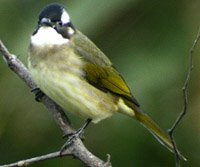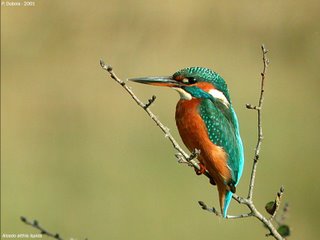Only since Christmas, I've become an official grown up member of the Woodward family. I have become a birdwatcher.
I didn't get the many-pocketed khaki vest and I don't have the tripod and telescope, or even a decent pair of binoculars, but I did receive a hardbound volume of A New Guide to the Birds of Taiwan, a first (and prossably last) printing. I have reason to believe that my father (er, Father Christmas) went to great lengths to find this book, as locating anything in the area of an English Taiwan birding guide stumped even my internet-combing prowess (and everything's on the internet; if it's not there, it doesn't exist).
I've said it before, and I'll say it again: this book is amazing. Now, it's no Golden Guide to North American Birds, but despite the basic printing and limited illustrations, it includes not only English and Chinese, but also the phonetic symbols for all the sounds in the Chinese tongue, aka, the Taiwan Chinese Phonetic alphabet, aka, (laugh if you want to, I did) bopomofo, so that I know how to pronounce all those crazy characters. I've been using this book, believe it or not, to identify birds. When I see one I write down the date and any other important details in the checklist in the back. Growing up, this is what I watched my father do, and later my brother would do the same. Please humor a few examples of the natural world that this guide has helped me to observe. Before I had a book to help me identify them, I saw the Chinese Bulbul all around campus. In the picture it's hard to see that he has a sort of golden-dusted olive colored back, which is especially lovely in the sunlight. Turns out he's pretty common, but a very friendly bird who especially enjoys perching on topmost branches. His song is heard ubiqitously throughout the well-shaded campus.
Before I had a book to help me identify them, I saw the Chinese Bulbul all around campus. In the picture it's hard to see that he has a sort of golden-dusted olive colored back, which is especially lovely in the sunlight. Turns out he's pretty common, but a very friendly bird who especially enjoys perching on topmost branches. His song is heard ubiqitously throughout the well-shaded campus. I've always believed that the female of most bird species gets the short end of the stick, especially when it comes to those named for their color. I spotted a vinaceous rosefinch while hiking on Jade Mountain (which has the highest peak in Northeast Asia, whatever that means). Had I not been carrying the volume with me, I would have thought nothing of the ordinary-looking bird, but seeing as how I could enlarge my schema of the mountain fauna, I discovered what a fabulous looking mate this one must have. He would have a wine-colored (that's what vinaceous means) head, back, and breast, with a striking silver-white eyebrow and brown wings and tail. But she's the one who came out for groceries in her housecoat while he stayed home, vainly arranging his feathers.
I've always believed that the female of most bird species gets the short end of the stick, especially when it comes to those named for their color. I spotted a vinaceous rosefinch while hiking on Jade Mountain (which has the highest peak in Northeast Asia, whatever that means). Had I not been carrying the volume with me, I would have thought nothing of the ordinary-looking bird, but seeing as how I could enlarge my schema of the mountain fauna, I discovered what a fabulous looking mate this one must have. He would have a wine-colored (that's what vinaceous means) head, back, and breast, with a striking silver-white eyebrow and brown wings and tail. But she's the one who came out for groceries in her housecoat while he stayed home, vainly arranging his feathers. While perusing the volume, I bookmarked birds that I especially wanted to find. Imagine my delight when I stumbled across the brilliant river kingfisher skimming the surface small pond in Taipei, crisscrossing it in seconds with a shrill cry. Barely touching the water, he found some dinner and took it to a secluded perch to enjoy it.
While perusing the volume, I bookmarked birds that I especially wanted to find. Imagine my delight when I stumbled across the brilliant river kingfisher skimming the surface small pond in Taipei, crisscrossing it in seconds with a shrill cry. Barely touching the water, he found some dinner and took it to a secluded perch to enjoy it.
Keep paying attention. This is where we'll start to build some substance. What I like best about this book is that the most important component of its contents cannot be bound. Not only do I search for its descriptions to be made manifest in the world around me, I take part in a communion with my family. For the Woodwards, observing birds bears an understood significance. A few winters ago my brother and I negotiated holiday traffic in order to keep an eye on a hunting kite. Visiting the mountain cottage of my (younger) youth, I whiled hours in a hammock or followed a trail, listening to my father emulate the call of a passing bird that it might linger in our neck of the woods long enough for us to have a look at it. Meanwhile, visitng hummingbirds made entries on my mother's keen mental log, alternately establishing dominance by chasing others away, preventing anyone, including themselves, from enjoying the sugarwater. At home, we had an ugly gray mug whose stamped precept made all things plain: "We're birdwatchers". Simply maintaining the birdfeeders at home became a perennial task for all members of the family; even the dog joined the campaign against marauding squirrels. (Of course her graceless attacks shuttled off all the birds too, but there's a margin for error in everything).
Additionally, (just when you thought it couldn't get better) fixation with this little book gives me a little bit more insight into the the Bible. True, A New Guide to the Birds of Taiwan has nothing on the inspired word of God, but an analogy always has to be simpler than what it describes. As a member of God's family, availed of His Word, I observe and grow in understanding. I seek truth as Biblical authors have framed it. I hope for the Lord's promises. I pray for mercy and grace, rely on forgiveness, and wait for the Holy Spirit, which I know about because I read it in the Bible. It's like putting the birds I have seen and want to see into perspective.
I wouldn't want to give the idea that the Bible is just a practical guide for Christian living. It would be easy to treat it that way, say if I read more out of the books of James and Proverbs than any other book. I would describe Christ's redemptive work as the opposite of expedient and certainly Job's account contributes almost nothing to the pragmatist's inventory, save for "what to scrape your boils with".
Along with observing my parents observe birds, I also observed them read and continue to discover the scriptures. Isaiah 55:10-11 says the Word of God is like rain that falls, yielding both seed and bread. As seed is to the beginning of faith, bread is the nourishment of faith. We as members of God's family can not exhaust his word; it always holds something new for us though it's been there the whole time, just as the Lord God has been and will be. As humans we can't eat once and expect to remain satisfied forever. We can't expect the lessons we learned in Sunday School or as youths to sustain our understanding of our risen Lord as our mind matures past the intellectual and spiritual stages of youth. Kierkegaard reminds us in Fear and Trembling that it takes a man even such as Abraham his whole life to grapple with his faith, leaning on it as means and ends of his existence. From my limited perspective, I can only imagine what this means.
I'll never see every bird in my bird book. I'll never see every bird in any bird book. But I'll know what it's like to look for birds and find them, just like anyone who learns to look for birds and find them.
11 March 2006
Membership Guide
Posted by
Anne
at
4:29 AM
![]()
![]()
